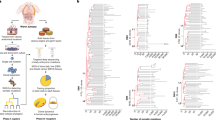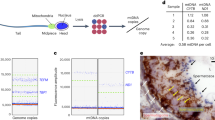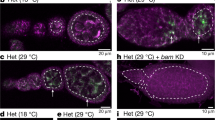Abstract
Observations of rapid shifts in mitochondrial DNA (mtDNA) variants between generations prompted the creation of the bottleneck theory. A prevalent hypothesis is that a massive reduction in mtDNA content during early oogenesis leads to the bottleneck1,2. To test this, we estimated the mtDNA copy number in single germline cells and in single somatic cells of early embryos in mice. Primordial germ cells (PGCs) show consistent, moderate mtDNA copy numbers across developmental stages, whereas primary oocytes demonstrate substantial mtDNA expansion during early oocyte maturation. Some somatic cells possess a very low mtDNA copy number. We also demonstrated that PGCs have more than 100 mitochondria per cell. We conclude that the mitochondrial bottleneck is not due to a drastic decline in mtDNA copy number in early oogenesis but rather to a small effective number of segregation units for mtDNA in mouse germ cells. These results provide new information for mtDNA segregation models and for understanding the recurrence risks for mtDNA diseases.
This is a preview of subscription content, access via your institution
Access options
Subscribe to this journal
Receive 12 print issues and online access
$209.00 per year
only $17.42 per issue
Buy this article
- Purchase on Springer Link
- Instant access to full article PDF
Prices may be subject to local taxes which are calculated during checkout



Similar content being viewed by others
References
Jansen, R.P. & de Boer, B.K. The bottleneck: mitochondrial imperatives in oogenesis and ovarian follicular fate. Mol. Cell. Endocrinol. 145, 81–88 (1998).
Krakauer, D.C. & Mira, A. Mitochondria and germ-cell death. Nature 400, 125–126 (1999).
Brown, W.M., George, M. Jr. & Wilson, A.C. Rapid evolution of animal mitochondrial DNA. Proc. Natl. Acad. Sci. USA 76, 1967–1971 (1979).
Brown, W.M., Prager, E.M., Wang, A. & Wilson, A.C. Mitochondrial DNA sequences of primates: tempo and mode of evolution. J. Mol. Evol. 18, 225–239 (1982).
Ashley, M.V., Laipis, P.J. & Hauswirth, W.W. Rapid segregation of heteroplasmic bovine mitochondria. Nucleic Acids Res. 17, 7325–7331 (1989).
Blok, R.B., Gook, D.A., Thorburn, D.R. & Dahl, H.H. Skewed segregation of the mtDNA nt 8993 (T → G) mutation in human oocytes. Am. J. Hum. Genet. 60, 1495–1501 (1997).
Laipis, P.J., Van de Walle, M.J. & Hauswirth, W.W. Unequal partitioning of bovine mitochondrial genotypes among siblings. Proc. Natl. Acad. Sci. USA 85, 8107–8110 (1988).
Larsson, N.G. et al. Segregation and manifestations of the mtDNA tRNA(Lys) A → G(8344) mutation of myoclonus epilepsy and ragged-red fibers (MERRF) syndrome. Am. J. Hum. Genet. 51, 1201–1212 (1992).
Olivo, P.D., Van de Walle, M.J., Laipis, P.J. & Hauswirth, W.W. Nucleotide sequence evidence for rapid genotypic shifts in the bovine mitochondrial DNA D-loop. Nature 306, 400–402 (1983).
Birky, C.W., Jr . Relaxed and stringent genomes: why cytoplasmic genes don't obey Mendel's laws. J. Hered. 85, 355–365 (1994).
Hauswirth, W.W. & Laipis, P.J. Mitochondrial DNA polymorphism in a maternal lineage of Holstein cows. Proc. Natl. Acad. Sci. USA 79, 4686–4690 (1982).
Marchington, D.R., Macaulay, V., Hartshorne, G.M., Barlow, D. & Poulton, J. Evidence from human oocytes for a genetic bottleneck in an mtDNA disease. Am. J. Hum. Genet. 63, 769–775 (1998).
Jenuth, J.P., Peterson, A.C., Fu, K. & Shoubridge, E.A. Random genetic drift in the female germline explains the rapid segregation of mammalian mitochondrial DNA. Nat. Genet. 14, 146–151 (1996).
Nass, M.M. Mitochondrial DNA. I. Intramitochondrial distribution and structural relations of single- and double-length circular DNA. J. Mol. Biol. 42, 521–528 (1969).
Piko, L. & Taylor, K.D. Amounts of mitochondrial DNA and abundance of some mitochondrial gene transcripts in early mouse embryos. Dev. Biol. 123, 364–374 (1987).
Smith, L.C., Thundathil, J. & Filion, F. Role of the mitochondrial genome in preimplantation development and assisted reproductive technologies. Reprod. Fertil. Dev. 17, 15–22 (2005).
Steuerwald, N. et al. Quantification of mtDNA in single oocytes, polar bodies and subcellular components by real-time rapid cycle fluorescence monitored PCR. Zygote 8, 209–215 (2000).
Nogawa, T., Sung, W.K., Jagiello, G.M. & Bowne, W. A quantitative analysis of mitochondria during fetal mouse oogenesis. J. Morphol. 195, 225–234 (1988).
Iborra, F.J., Kimura, H. & Cook, P.R. The functional organization of mitochondrial genomes in human cells. BMC Biol. 2, 9 (2004).
Legros, F., Malka, F., Frachon, P., Lombes, A. & Rojo, M. Organization and dynamics of human mitochondrial DNA. J. Cell Sci. 117, 2653–2662 (2004).
Battersby, B.J., Loredo-Osti, J.C. & Shoubridge, E.A. Nuclear genetic control of mitochondrial DNA segregation. Nat. Genet. 33, 183–186 (2003).
Wallace, D.C. The mitochondrial genome in human adaptive radiation and disease: on the road to therapeutics and performance enhancement. Gene 354, 169–180 (2005).
Kono, T., Obata, Y., Yoshimzu, T., Nakahara, T. & Carroll, J. Epigenetic modifications during oocyte growth correlates with extended parthenogenetic development in the mouse. Nat. Genet. 13, 91–94 (1996).
Nagy, A., Gertsenstein, M., Vintersten, K. & Behringer, R. Manipulating the Mouse Embryo (Cold Spring Harbor Laboratory Press, Cold Spring Harbor, NY, 2003).
Solter, D. & Knowles, B.B. Immunosurgery of mouse blastocyst. Proc. Natl. Acad. Sci. USA 72, 5099–5102 (1975).
Kaneda, H. et al. Elimination of paternal mitochondrial DNA in intraspecific crosses during early mouse embryogenesis. Proc. Natl. Acad. Sci. USA 92, 4542–4546 (1995).
Shitara, H. et al. Selective and continuous elimination of mitochondria microinjected into mouse eggs from spermatids, but not from liver cells, occurs throughout embryogenesis. Genetics 156, 1277–1284 (2000).
Yoshimizu, T. et al. Germline-specific expression of the Oct-4/green fluorescent protein (GFP) transgene in mice. Dev. Growth Differ. 41, 675–684 (1999).
D'Herde, K., Callebaut, M., Roels, F., de Prest, B. & van Nassauw, L. Homology between mitochondriogenesis in the avian and amphibian oocyte. Reprod. Nutr. Dev. 35, 305–311 (1995).
Meirelles, F.V. & Smith, L.C. Mitochondrial genotype segregation during preimplantation development in mouse heteroplasmic embryos. Genetics 148, 877–883 (1998).
Acknowledgements
We thank N. Takahata and K. Fischer Lindahl for valuable comments and discussions. This work was supported in part by Grants-in-Aid (numbers 14GS0305 and 16770009) from the Ministry of Education, Culture, Sports, Science and Technology of Japan, and national funds from the Ministry of Economy, Trade and Industry of Japan and the New Energy and Industrial Technology Development Organization (NEDO (the Nakano research group)).
Author information
Authors and Affiliations
Contributions
This study was designed by H.S., L.C., J.-I.H. and H.Y. and written by L.C., H.S. and H.Y. The transgenic mice were generated by K.A.; PGCs were prepared by H.S., L.C., T. Horii, Y.N., H.I. and T. Hara and other experimental procedures were done by L.C. and H.S.
Corresponding author
Ethics declarations
Competing interests
The authors declare no competing financial interests.
Supplementary information
Supplementary Fig. 1
Distribution of mtDNA copy number in single M primordial germ cells from 7.5- to 13.5-dpc mice. (PDF 493 kb)
Supplementary Fig. 2
Distribution of mtDNA copy number in single L primordial germ cells from 7.5- to 13.5-dpc mice. (PDF 479 kb)
Supplementary Fig. 3
Mitochondria in 9.5-dpc mouse primordial germ cell. (PDF 1524 kb)
Supplementary Fig. 4
Mitochondria in 12.5-dpc mouse primordial germ cell. (PDF 2028 kb)
Supplementary Table 1
Primer and probe sequences. (PDF 12 kb)
Supplementary Video 1
Mitochondria in 9.5-dpc mouse primordial germ cell (lower cell). (MOV 895 kb)
Supplementary Video 2
Mitochondria in 12.5-dpc mouse primordial germ cell. (MOV 543 kb)
Rights and permissions
About this article
Cite this article
Cao, L., Shitara, H., Horii, T. et al. The mitochondrial bottleneck occurs without reduction of mtDNA content in female mouse germ cells. Nat Genet 39, 386–390 (2007). https://doi.org/10.1038/ng1970
Received:
Accepted:
Published:
Issue Date:
DOI: https://doi.org/10.1038/ng1970
This article is cited by
-
CENP-F-dependent DRP1 function regulates APC/C activity during oocyte meiosis I
Nature Communications (2022)
-
Modulating Mitochondrial DNA Heteroplasmy with Mitochondrially Targeted Endonucleases
Annals of Biomedical Engineering (2022)
-
Reduction of mtDNA heteroplasmy in mitochondrial replacement therapy by inducing forced mitophagy
Nature Biomedical Engineering (2022)
-
Oxygen tension modulates the mitochondrial genetic bottleneck and influences the segregation of a heteroplasmic mtDNA variant in vitro
Communications Biology (2021)
-
The special considerations of gene therapy for mitochondrial diseases
npj Genomic Medicine (2020)



